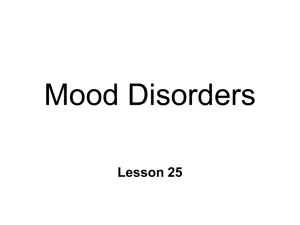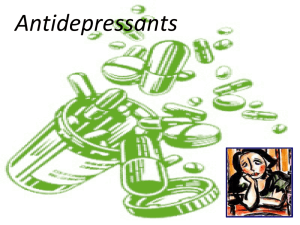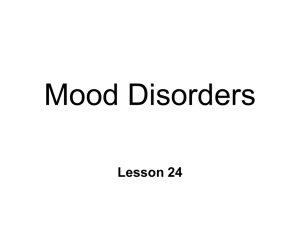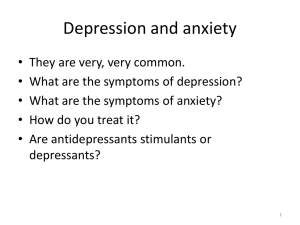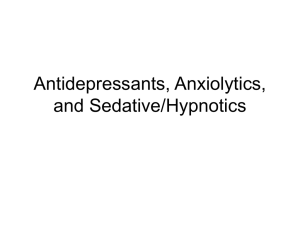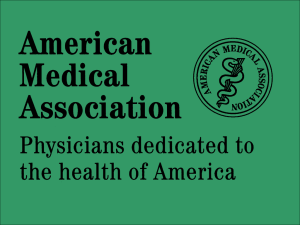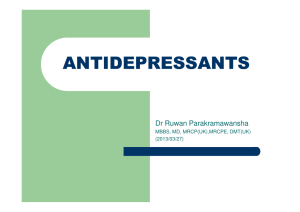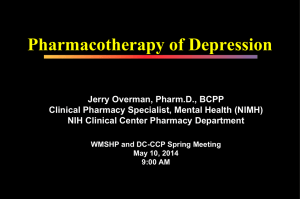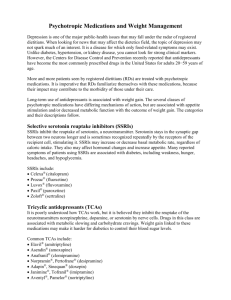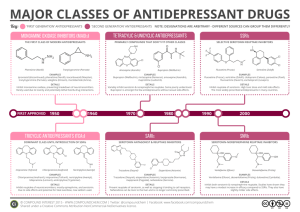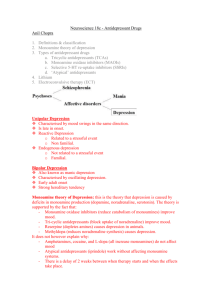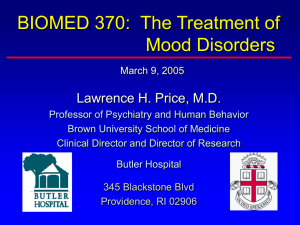August 2005 - ManchesterPsychiatry.net
advertisement
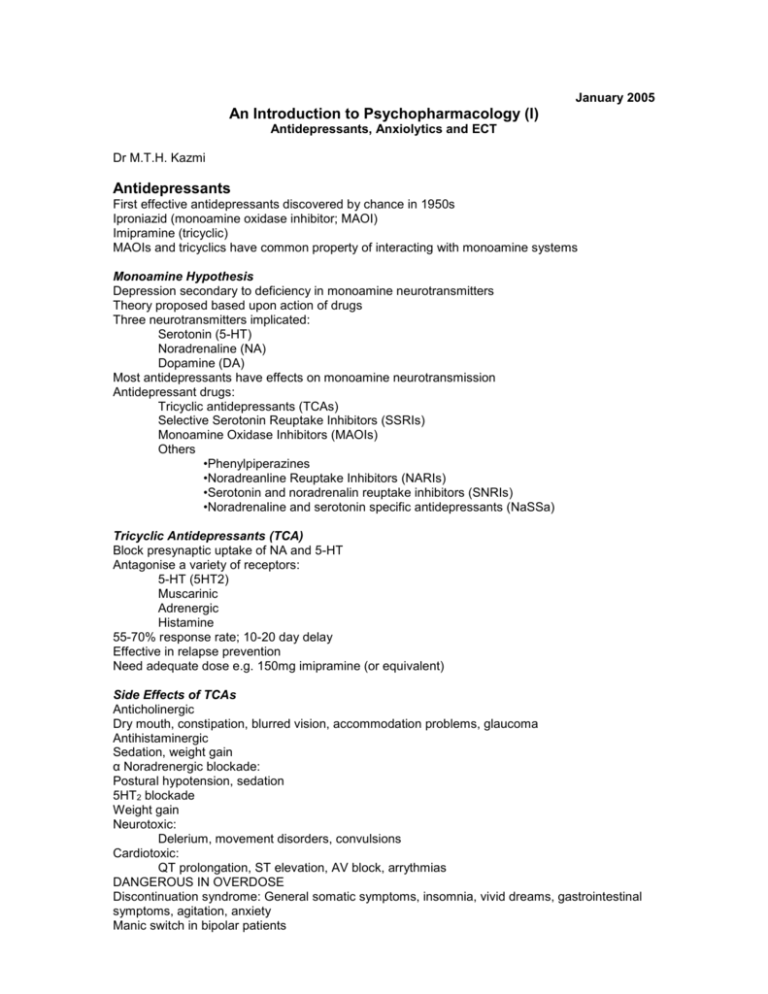
January 2005 An Introduction to Psychopharmacology (I) Antidepressants, Anxiolytics and ECT Dr M.T.H. Kazmi Antidepressants First effective antidepressants discovered by chance in 1950s Iproniazid (monoamine oxidase inhibitor; MAOI) Imipramine (tricyclic) MAOIs and tricyclics have common property of interacting with monoamine systems Monoamine Hypothesis Depression secondary to deficiency in monoamine neurotransmitters Theory proposed based upon action of drugs Three neurotransmitters implicated: Serotonin (5-HT) Noradrenaline (NA) Dopamine (DA) Most antidepressants have effects on monoamine neurotransmission Antidepressant drugs: Tricyclic antidepressants (TCAs) Selective Serotonin Reuptake Inhibitors (SSRIs) Monoamine Oxidase Inhibitors (MAOIs) Others •Phenylpiperazines •Noradreanline Reuptake Inhibitors (NARIs) •Serotonin and noradrenalin reuptake inhibitors (SNRIs) •Noradrenaline and serotonin specific antidepressants (NaSSa) Tricyclic Antidepressants (TCA) Block presynaptic uptake of NA and 5-HT Antagonise a variety of receptors: 5-HT (5HT2) Muscarinic Adrenergic Histamine 55-70% response rate; 10-20 day delay Effective in relapse prevention Need adequate dose e.g. 150mg imipramine (or equivalent) Side Effects of TCAs Anticholinergic Dry mouth, constipation, blurred vision, accommodation problems, glaucoma Antihistaminergic Sedation, weight gain α Noradrenergic blockade: Postural hypotension, sedation 5HT2 blockade Weight gain Neurotoxic: Delerium, movement disorders, convulsions Cardiotoxic: QT prolongation, ST elevation, AV block, arrythmias DANGEROUS IN OVERDOSE Discontinuation syndrome: General somatic symptoms, insomnia, vivid dreams, gastrointestinal symptoms, agitation, anxiety Manic switch in bipolar patients TCA Contraindications Heart block, arrythmias Hypomania or mania Recent MI Severe liver disease TCAs: Common Examples Amitriptyline Imipramine Clomipramine Dosulepin (Dothiepin) Lofepramine Selective Serotonin Reuptake Inhibitors - SSRIs Relatively selective 5-HT re-uptake blockade Effectiveness: 55-70% response rate 10-20 day delay in response Little evidence of dose-response relationship Safer in overdose Useful in anxiety/OCD Used 1st line in depression SSRI Side Effects Nausea/vomiting Agitation Akathisia Sedation/dizziness Sexual dysfunction Seizures (rare) Discontinuation syndrome Controversial: ? Increased risk of suicide SSRIs: Common Examples Fluoxetine (Prozac) Paroxetine (Seroxat) Citalopram Sertraline Monoamine Oxidase Inhibitors - MAOIs MAO present in periphery as well as CNS MAO-A metabolises NA, 5-HT and tyramine MAO-B metabolises DA, tyramine and phentylamine MAOIs increase the storage and release of 5-HT and NA MAOIs Traditional MAOIs cause irreversible inhibition Moclobemide Reversible Inhibitor of MAO-A (RIMA) MAOIs Now used 3rd line Useful in: Severe depression Anxiety states/OCD Treatment resistance depression Atypical depression MAOIs: Side Effects Postural hypotension Restlessness Insomnia Nausea Dizziness Sexual dysfunction Sweating Tremor MAOIs: Interactions Hypertensive Reaction (Cheese reaction) Flushing, headache, increased BP, rarely CVA Causes Consumption of tyramine containing foods EG Cheese, yeast extracts, some alcoholic drinks also cold remedies Prevention Education, food warning labels MAOIs Contraindications Cardiovascular disease Cerebrovascular disease Children Epilepsy Hepatic disease Phaechromocytoma Hyperthyroidism MAOIs: Examples Phenelzine (Traditional) Moclobemide (RIMA) Phenylpiperazines Example: Trazadone Relatively weak 5-HT reuptake inhibition 5HT2 antagonist properties Safe in OD Sedative Noradrenaline Reuptake Inhibitors (NARI) Example: reboxetine May have alerting properties Serotonin and Noradrenaline Reuptake Inhibitors - SNRIs Examples: Venlafaxine Duloxetine (newly licensed) Venlafaxine: Selective uptake of 5-HT and NA NA uptake evident only at higher doses May be more effective in severe depression SNRIs: Venlafaxine NICE guidance December 2004 Restricted to 2nd line use Only to be initiated by Psychiatrists ECG and BP monitoring recommended Noradrenaline and Serotonergic-Specific Antidepressant (NaSSa) Most common example: Mirtazepine 5-HT2, 5-HT3, antihistaminergic, and α2 antagonist Sedative Minimises sexual dysfunction and nausea Causes weight gain Mirtazepine: mechanism of action Activates NA neurones by blocking negative feedback (presynaptic α2) Increased noradrenergic activity stimulates 5-HT neurone activity in the brainstem Blockade of α2 receptors on 5-HT terminals in the cortex enhances 5-HT release Net effect: more 5-HT and NA Using Antidepressants Effectively Use only if indicated: depression should be at least moderately severe NOT for mild depression Use therapeutic dose Use for adequate time period 6-12 months post remission for single episode Longer for recurrent depressive disorder Anxiolytics Benozodiazepines and related compounds Barbituates Antidepressants 5-HT1A agonists (buspirone) β Blockers Antipsychotics Benzodiazepines Act at benzodiazepine receptors attached to GABAA receptors GABA – Principal inhibitory transmitter in CNS Benzodiazepines act as agonists Enhance action of GABA Benzodiazepines: Actions Anxiolytic Hypnotic Anticonvulsant Muscle relaxant Amnesic Impair psychomotor function Benzodiazepines: Indications Short term use for severe anxiety Short term use for insomnia Alcohol withdrawal Seizures Severe agitation Rapid tranquilisation of disturbed behaviour Benzodiazepines: Side Effects Tolerance and dependence Day time sedation Respiratory depression (parental use) Dry mouth, blurred vision, GI upset, headache, risk of falls in elderly Amnesia, restlessness, disinhibition Benzodiazepine Withdrawal Effects Rebound insomnia Anxiety Sensory disturbance Tremor Confusion Restlessness Nausea, anorexia Managing Withdrawal Switch to longer acting drug e.g. diazepam Gradual reduction in dose over 4 – 16 weeks Monitor for increased alcohol consumption Using benzodiazepines appropriately Identify causes of anxiety and insomnia and treat appropriately Reserve for severe symptoms Use lowest effective dose Short courses (2 – 4 weeks) Avoid repeat prescriptions Warn re dependence and tolerance Benzodiazepines: Common examples Diazepam: Long acting Active metabolite Lorazepam: Short acting More appropriate for emergencies and parental use Benzodiazepines: Related Compounds Newer hypnotics Zopiclone Zolpidem Zaleplon Act on GABA receptors but are different pharmocodynamically from benzodiazepines Benzodiazepines: Related Compounds Claimed to be ‘cleaner‘ Short acting Less dependence/withdrawal However, little compelling evidence Barbituates Rarely used now (epilepsy, anaesthesia) Historical interest 1960: 15,000,000 prescriptions for barbituates in UK GABA agonist (non BDZ site) Tolerance and dependence Problems with withdrawal Abused by addicts Antidepressants as Anxiolytics RCTs have demonstrated efficacy of TCAs for Anxiety associated with depression Generalised Anxiety Disorder (GAD) Panic disorder (clomipramine, imipramine) Obsessive Compulsive Disorder (OCD) SSRIs effective across range of anxiety disorders Antidepressants as Anxiolytics SSRIs 1st line for: GAD, PTSD, social phobia, panic disorder and OCD Serotonergic TCAs 2nd line for: Panic disorder (clomipramine, imipramine) OCD (clomipramine) Efficacy in anxiety disorders probably related to effect on 5-HT system Antipsychotics Low dose antipsychotics used from 1950s onwards Mainly chlorpromazine and thioridazine Very few clinical trials Useful for short term use in treatment of severe anxiety/agitation Atypicals increasingly used (off licence) β-Blockers Beneficial in situational/performance anxiety May help in GAD/panic disorder with physiological symptoms Useful in akathisia 5-HT1A agonists Buspirone Effective in GAD Not used often Electro-Convulsive Therapy Discovered ‘accidentally’ Initially used as treatment for schizophrenia Schizophrenia and epilepsy thought to be antithetical Seizures first induced chemically Electrically induced seizures from 1930s onwards Trials in 1960s, 70s and 80s demonstrated ECT as effective treatment for depression Mode of action poorly understood Effects on monoamine systems; particularly DA Poor media image, remains controversial treatment ECT: Indications According to NICE guidance Severe depression Mania Catatonia Use restricted to short term and for rapid relief Other treatments have failed ECT: Procedure Aim: safely induce generalised tonic-clonic seizure for 25s EEG monitoring recommended Given under GA with muscle relaxant Electrical stimulus applied via two electrodes Usually given twice weekly, up to 12 treatments in total ECT: Efficacy Extremely effective in depressive disorder Response rates: 60-80% Efficacy and side effects appear dose related Relapse rates high Patients normally continued on antidepressants to reduce relapse rates ECT: Side Effects Acute confusion Headache Amnesia – normally patchy, transient Anterograde Retrograde Serious side effects rare Mortality 1 in 20,000 (same as GA) ECT: Contraindications Absolute Contraindications Raised ICP Recent CVA Vascular aneurysms Recent MI Relative Contraindications Pregnancy History of CVA Cerebral tumour Retinal detachment
